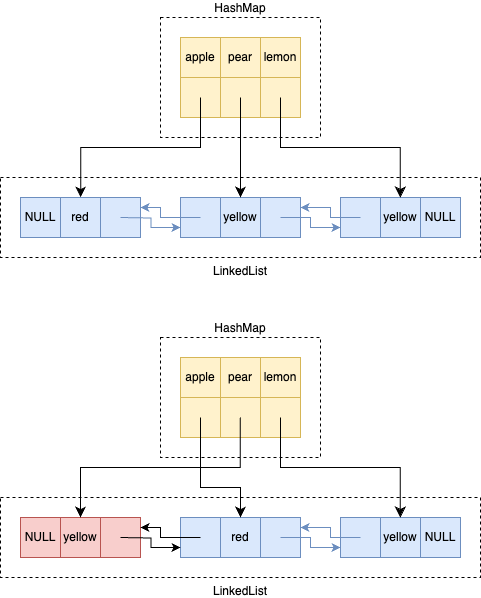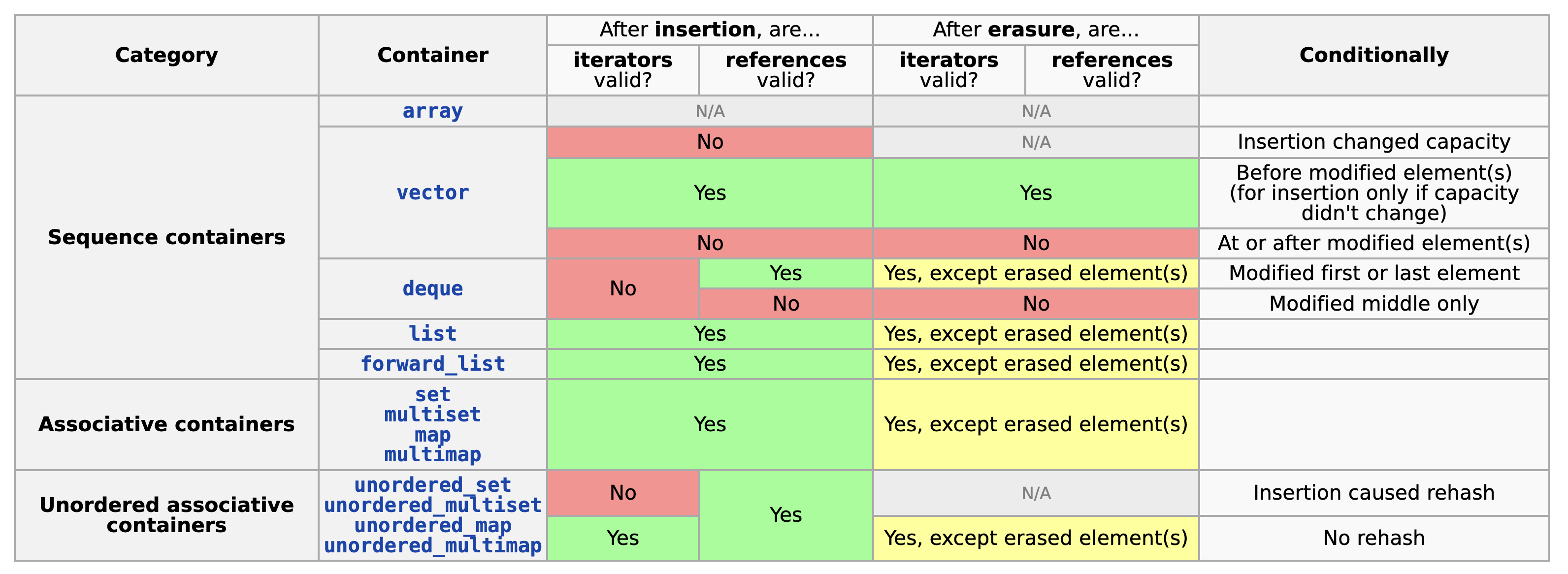LRU Cache 是工业界最常用的数据结构之一,而最简单的实现方式是基于 HashMap 和链表。当访问某个 entry 时,这个 entry 会被移到链表的最前端。
Rust 有个 crate lru 实现了这个数据结构,这里摘取了几个关键方法:
1 2 3 4 5 6 7 8 impl <K: Eq + Hash, V> LruCache<K, V> {pub fn new (cap: usize ) -> LruCache<K, V> {todo!()}pub fn len (&self ) -> usize {todo!()}pub fn put (&mut self , k: K, v: V) -> Option <V> {todo!()}pub fn get <'a >(&'a mut self , k: &K) -> Option <&'a V> {todo!()}pub fn peek_mut <'a >(&'a mut self , k: &K) -> Option <&'a mut V> {todo!()}
相比于 lru ,这里对函数签名做了一些简化,省去了与 Borrow trait 有关的优化。
可以看到,与常规数据结构不同的是,这里的 get 方法,也需要接受 &mut self,这给使用者带来很多困扰。例如我们可能希望同时持有多个 V 的不可变引用,这可以允许我们减少不必要的 copy,或者并发地使用他们。
1 2 3 4 let x = cache.get (&"a" ).unwrap ().as_str ();let y = cache.get (&"b" ).unwrap ().as_str ();let z = cache.get (&"c" ).unwrap ().as_str ();join (" " );
我们会得到如下报错:
1 2 3 4 5 6 7 8 9 error [E0499]: cannot borrow `cache` as mutable more than once at a time 20 | let x = cache.get (&"a" ).unwrap().as_str();first mutable borrow occurs here21 | let y = cache.get (&"b" ).unwrap().as_str();22 | let z = cache.get (&"c" ).unwrap().as_str();second mutable borrow occurs here23 | [x, y, z].join (" " );first borrow later used here
很显然,LruCache::get 使用了 &mut cache 导致 x 已经占有了 cache 的可变引用,而后面尝试创建 y、z 多个 &mut cache 同时存在违背了 Rust 的 borrow checker。
那么 Borrowck 认为是错的,就是错的吗?如果我们再看一眼上图演示的 LruCache 在 get 过程中的调整,我们会发现这个限制是完全没有道理的。get 确实会调整 LruCache 的结构,但并不会影响 val 的指针,第二次 get 完全不会让第一个 get 获得的 &V 失效。
那么反正实现是 unsafe 的,我们可以将 get 改成接受 &self 吗?
1 pub fn get <'a >(&'a self , k: &K) -> Option <&'a V> {todo!()}
这显然是错的,接受 &self 意味着我们可以并发调用 get 方法,链表就会被彻底破坏导致 UB,除非我们使用 Arc<Mutex<_>> / AtomicPtr 等同步原语保护链表节点引入不必要的 overhead,或者将 LruCache 标记为 !Sync,这与我们原本的目的背道而驰了。
我们希望有一种接口设计,它不允许我们并发调用 get 方法,但 get 返回的 &V 不独占整个 cache,从而允许我们合法地同时持有多个 &V.
1 pub fn get <'cache , 'key >(&'cache self , k: &'key K) -> Option <&'? V> {todo!()}
这个函数目前有两个生命周期参数,一个是对 cache 的引用 'cache(前文中的 'a) ,另一个则是完全无关,甚至可能非常短的 'key (在前文中我们利用 rust 的规则省略了这个参数)。这两个都不可能描述我们返回值的生命周期,我们需要一个更好的生命周期参数,基于这个思路,我们尝试引入了一个新的生命周期:'token。
1 2 pub struct Token ;pub fn get <'cache , 'key , 'token >(&'cache self , k: &'key K, token: &'token Token) -> &'token V { todo!() }
这样我们之前同时持有多个 &V 的代码就能编译通过了!Happy Ending?
1 2 3 4 5 6 let token = Token;let x = cache.get (&"a" , &token).unwrap ().as_str ();let y = cache.get (&"b" , &token).unwrap ().as_str ();let z = cache.get (&"c" , &token).unwrap ().as_str ();put ("a" , "b" .to_string ());join (" " );
我们很快发现在修改了 get 的签名后,我们在 safe rust 中,在 &V 仍然合法时调用 put。这个方法会覆盖现有的 value,或者淘汰最旧的 entry。被覆盖的 entry 会在返回后被 drop。在此之后我们继续访问 x 就会导致 UB。办法也非常简单,我们只需要修改 put 的签名即可。
1 pub fn put <'cache ,'token >(&mut self , k: K, v: V, token: &'token mut Token) -> Option <V> {todo!()}
1 2 3 4 5 let x = cache.get (&"a" , &token).unwrap ().as_str ();let y = cache.get (&"b" , &token).unwrap ().as_str ();let z = cache.get (&"c" , &token).unwrap ().as_str ();put ("a" , "b" , &mut cache, &mut token);join (" " );
由于 put 需要 &mut Token 作为参数,而 &Token 已经被 x/y/z 不可变引用了,这里会编译失败。
现在我们可以给 Token 一个更好的名字了,不难发现,Token 其实是对 value 本身的读写权限。我们将它重命名为 ValuePerm。
持有 &self,代表对 LruCache 的结构有读权限。
持有 &mut self,代表对 LruCache 的结构的结构有写权限。
持有 &perm,代表对 LruCache 的 value 有读权限。
持有 &mut perm,代表对 LruCache 的 value 有写权限。
1 2 3 4 5 6 7 8 impl <K: Eq + Hash, V> LruCache<K, V> {pub fn new (cap: usize ) -> LruCache<K, V> {todo!()}pub fn len (&self ) -> usize {todo!()}pub fn put <'cache , 'perm >(&'cache mut self , k: K, v: V, perm: &'perm mut ValuePerm) -> Option <V> {todo!()}pub fn get <'cache , 'perm >(&'cache mut self , k: &K, perm: &'perm ValuePerm) -> Option <&'perm V> {todo!()}pub fn peek_mut <'cache , 'perm >(&'cache self , k: &K, perm: &'perm ValuePerm) -> Option <&'perm mut V> {todo!()}
我们选取的函数是非常典型的四种用例。一个意外的收获是,由于 peek_mut 不持有 &mut self,它返回的引用可以和 len 同时调用,虽然这可能是个没什么用的 feature。
1 2 3 let val_mut = cache.peek_mut (&"a" , &mut perm);let len = cache.len ();
下一个要解决的问题是唯一性。很显然,一个 LruCache 只能被一个 Token 操纵,这里我借鉴了 Ghost Cell 和 std::thread::scope
1 2 3 4 5 6 7 8 9 10 11 12 13 14 15 16 17 18 19 20 21 22 23 24 type InvariantLifetime <'brand > = PhantomData<fn (&'brand ()) -> &'brand ()>;pub struct ValuePerm <'brand > {'brand >,pub struct LruCache <'brand , K, V> {'brand >,impl <'brand , K: Eq + Hash, V> LruCache<'brand , K, V> {pub fn new_lru_cache <K, V, F>(fun: F)where for <'brand > FnOnce (ValuePerm<'brand >, LruCache<'brand , K, V>),let perm = ValuePerm {default (),let cache = LruCache::<K, V> {Default ::default (),Default ::default (),fun (perm, cache);
我们移除了 LruCache::new 方法,强制通过 new_lru_cache 创造一个 scope,并且在 scope 内使用。LruCache 和 ValuePerm 共享一个唯一的生命周期作为 ID。
1 2 3 4 5 6 7 8 9 new_lru_cache (|mut perm, mut cache| {put ("a" , "b" .to_string (), &mut perm);put ("b" , "c" .to_string (), &mut perm);put ("c" , "d" .to_string (), &mut perm);let x = cache.get (&"a" , &perm).unwrap ().as_str ();let y = cache.get (&"b" , &perm).unwrap ().as_str ();let z = cache.get (&"c" , &perm).unwrap ().as_str ();join (" " );
实现到这里的时候,我发现我忘了一个非常致命的问题,我可以修改所有的方法来接受 &mut Perm,但没法修改 Drop ,这可能导致 cache 早于 &V 被释放。而使用 'cache: 'perm 作为 constraint 会导致 &V 再次被 &'cache mut self 限制。
1 2 3 4 5 6 7 8 9 10 new_lru_cache (|mut perm, mut cache| {put ("a" , "b" .to_string (), &mut perm);put ("b" , "c" .to_string (), &mut perm);put ("c" , "d" .to_string (), &mut perm);let x = cache.get (&"a" , &perm).unwrap ().as_str ();let y = cache.get (&"b" , &perm).unwrap ().as_str ();let z = cache.get (&"c" , &perm).unwrap ().as_str ();drop (cache);join (" " );
如果 Rust 有 linear type 支持的话,我们可以阻止 LruCache 被 drop,必须通过类似 consume(self, &mut ValuePerm) 之类的方法来销毁,很遗憾的是 linear type 属于有生之年系列,因此我这里用了另一个 workaround:
1 2 3 pub fn new_lru_cache <K, V, F>(fun: F)where for <'brand > FnOnce (ValuePerm<'brand >, LruCache<'brand , K, V>) -> (ValuePerm<'brand , LruCache<'brand , K, V>>),
这里要求 new_lru_cache 接受的回调必须将 perm 和 value 的所有权返回再统一 drop。由于 'brand 的唯一性,回调必须将变量返回而无法提前销毁。
1 2 3 4 5 6 7 8 9 10 11 new_lru_cache (|mut perm, mut cache| {put ("a" , "b" .to_string (), &mut perm);put ("b" , "c" .to_string (), &mut perm);put ("c" , "d" .to_string (), &mut perm);let x = cache.get (&"a" , &perm).unwrap ().as_str ();let y = cache.get (&"b" , &perm).unwrap ().as_str ();let z = cache.get (&"c" , &perm).unwrap ().as_str ();join (" " );
至此我们的接口设计就大功告成了,具体实现几乎可以完全从 lru copy,反正 unsafe 可以操纵一切,我们只要保证上层接口足够安全就行。
我实现了一个简单的完整可用版本,开源在 https://github.com/TennyZhuang/ref-stable-lru ,并且已经发布到 crates.io ref-stable-lru ,感兴趣的可以试玩一下,特别是提出一些 unsound 的宝贵意见。
Reference Stability in C++ STL 熟悉 C++ 的朋友都知道,C++ STL 有一个非常黑暗的概念,叫 reference/iterator stability,或者叫 reference/iterator invalidation。在 cppreference 中,我们可以找到这样一张图,它描述了各个 containers 在各种操作下的行为。
这个 feature 是 C++ UB 的重灾区之一,主要原因是只在 doc 里提到,完全没法在签名上约束。而 Rust 完全阻止了相关的行为,Rust 标准库的所有 collection,只要你持有任何一个 reference,你都无法对这个结构进行任何操作,这其实浪费了 collection 的很多特性。这篇文章的设计思路是将 collection 的操作权限分散到各个 Perm 上,从而提供细粒度的读写权限控制,这个思想高度借鉴了 Ghost Cell 。用类似的思路,我们也可以实现一些其他常用的数据结构,例如持有引用的同时可以 push 的 VecDeque。

